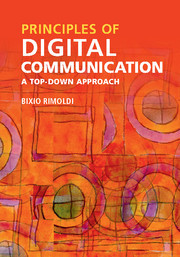Description
Principles of Digital Communication
A Top-Down Approach
Author: Rimoldi Bixio
A comprehensive text that takes a unique top-down approach to teaching the fundamentals of digital communication for a one-semester course.
Language: English
Subject for Principles of Digital Communication:
Publication date: 01-2016
269 p. · 18x25.3 cm · Hardback
269 p. · 18x25.3 cm · Hardback
Description
/li>Contents
/li>Biography
/li>
This comprehensive and accessible text teaches the fundamentals of digital communication via a top-down-reversed approach, specifically formulated for a one-semester course. The unique approach focuses on the transmission problem and develops knowledge of receivers before transmitters. In doing so it cuts straight to the heart of the digital communication problem, enabling students to learn quickly, intuitively, and with minimal background knowledge. Beginning with the decision problem faced by a decoder and going on to cover receiver designs for different channels, hardware constraints, design trade-offs, convolutional coding, Viterbi decoding, and passband communication, detail is given on system-level design as well as practical applications in engineering. All of this is supported by numerous worked examples, homework problems, and MATLAB simulation exercises to aid self-study, providing a solid basis for students to specialize in the field of digital communication and making it suitable for both traditional and flipped classroom teaching.
1. Introduction and objectives; 2. Receiver design for discrete-time observations: first layer; 3. Receiver design for the continuous-time AWGN channel: second layer; 4. Signal design trade-offs; 5. Symbol-by-symbol on a pulse train: second layer revisited; 6. Convolutional coding and Viterbi decoding: first layer revisited; 7. Passband communication via up/down conversion: third layer.
Bixio Rimoldi is a Professor at the École Polytechnique Fédérale de Lausanne (EPFL), Switzerland, where he developed an introductory course on digital communication. Previously he was Associate Professor at Washington University and took visiting positions at Stanford University, the Massachusetts Institute of Technology, and the University of California, Berkeley. He is an IEEE fellow, a past president of the IEEE Information Theory Society, and a past director of the communication system program at EPFL.
© 2024 LAVOISIER S.A.S.
These books may interest you

Fundamentals of Convolutional Coding 147.98 €



